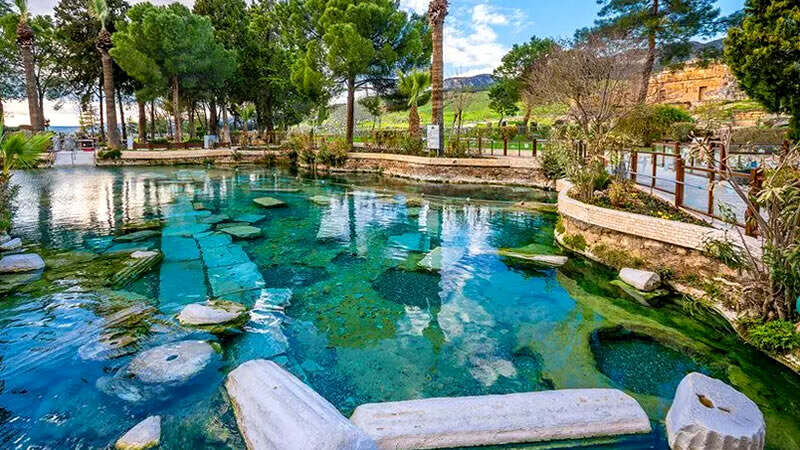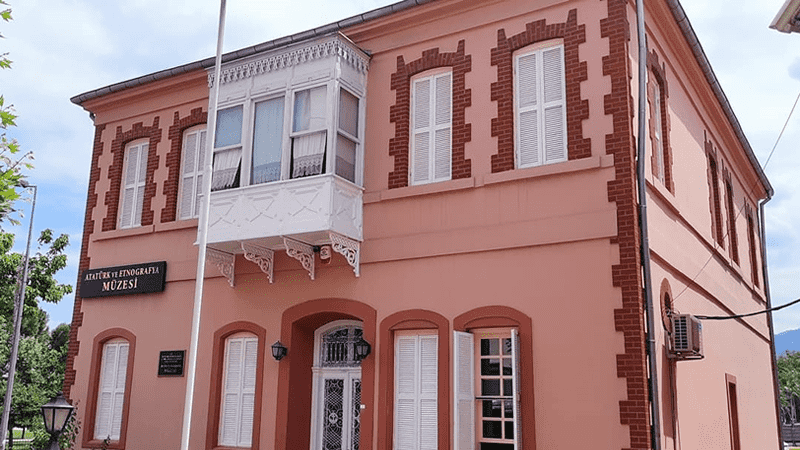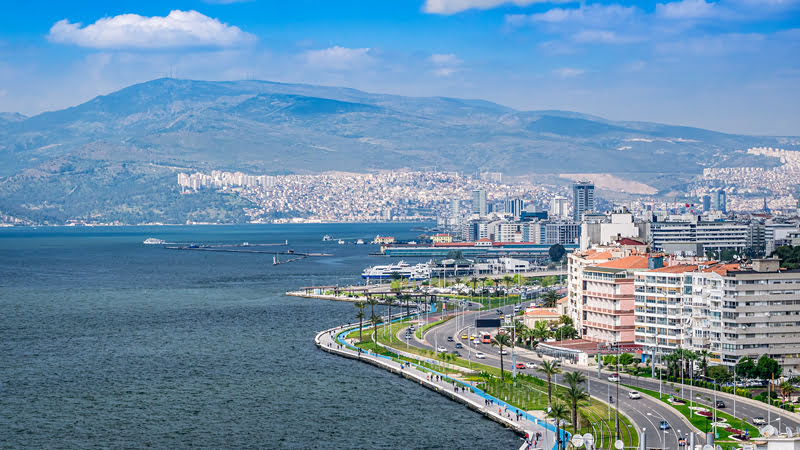Cleopatra Pool of Denizli - The Healing and Beauty Center of Ancient Times

Famous for Pamukkale's travertines and the ancient city of Hierapolis, Denizli offers a perfect blend of history and nature with its globally renowned Cleopatra Pool. The Cleopatra Pool is not only a pool fed by the region's thermal waters but also a unique structure that brings the spirit of ancient times to the present. This article provides a detailed examination of the history, legends, natural features, contributions to health tourism, and the amenities offered to visitors at Cleopatra Pool.
The formation of Cleopatra Pool is linked to a major earthquake in the 7th century AD. This earthquake caused the collapse of large columns in the ancient city of Hierapolis, creating a depression that filled with thermal waters.
The pool is named after the famous Egyptian Queen Cleopatra. According to legend, Queen Cleopatra bathed in this pool and attributed her beauty to the healing minerals in these waters. However, the claim that the queen bathed here remains only a legend, without any historical basis.
This legend has contributed to the enduring popularity of Cleopatra Pool over the centuries. In ancient times, people would visit this pool to preserve their beauty and find healing for their health. Today, this quest for wellness continues to attract visitors to Cleopatra Pool. With its rich history from the depths of time, the pool remains a significant point of interest.
The water of Cleopatra Pool is fed by the region's thermal sources and is famous for its mineral content. The water temperature remains stable at around 36 degrees Celsius year-round, ideal for relaxation and muscle relief. The water is rich in minerals like calcium, magnesium, sulfate, and bicarbonate, which have a softening and rejuvenating effect on the skin, giving visitors a refreshed look.
In ancient times, it was believed that these waters were beneficial for skin diseases, joint disorders, and circulation issues. Today, with support from modern medicine, it is known that the healing waters of Cleopatra Pool have positive effects on these types of ailments. The thermal waters also aid in detoxifying the body, providing a general detox effect. Thus, Cleopatra Pool holds both historical value and a significant place in modern health tourism.
Cleopatra Pool stands out not only for its thermal waters but also for the ancient remnants within its structure. Columns, marble blocks, and statue fragments from the Roman era at the bottom of the pool reflect the rich past of Hierapolis. These remnants, dislodged by earthquakes over time, naturally settled in the pool, preserving them in place.
Visitors have the chance to swim among these ancient remnants, experiencing a near-touch with history. These artifacts at the pool's bottom showcase the architectural features of the Roman era, creating an open-air museum feel underwater. These structures, carrying traces of Ancient Rome, are among the distinguishing features of Cleopatra Pool compared to other thermal pools.
Pamukkale is known worldwide for its white travertine terraces, which are located right next to Cleopatra Pool. These terraces form as calcium carbonate from underground waters precipitates on the surface. The white terraces have become an icon of Pamukkale and have earned the area a spot on the UNESCO World Heritage List.
Located right beside these travertines, Cleopatra Pool offers visitors a historical and natural experience. The travertines of Pamukkale take on shades of white, yellow, and orange under sunlight, creating a captivating view as you swim in the pool. Combined with the visual splendor of the travertines, the pool offers visitors a truly magical atmosphere.
As in ancient times, Cleopatra Pool remains a destination for those seeking health and beauty. The minerals in the thermal waters accelerate skin renewal and detoxify the body. Additionally, the water temperature relaxes muscles and reduces stress, providing visitors with both physical and mental relaxation.
In modern health tourism, Cleopatra Pool is especially popular for its positive effects on conditions like skin diseases, rheumatism, and joint problems. The healing offered by the pool continues as a tradition from centuries past, making it attractive to both domestic and international tourists.
Pamukkale attracts attention not only with Cleopatra Pool but also with its other historical and natural wonders nearby. The ancient city of Hierapolis is one of Pamukkale's most important historical structures. The ancient theater, Roman baths, agora, and necropolis are must-see locations within this ancient city. Known as a health center in ancient times, Hierapolis has carried its reputation to the present day, alongside Cleopatra Pool.
When visiting Pamukkale, a walk on the white travertine terraces is a must. Walking barefoot on the travertines offers an unforgettable experience that allows you to feel the unique natural structure of the area. Additionally, reaching the upper parts of the terraces allows you to enjoy Pamukkale's panoramic views. Alongside the travertines, other notable nearby destinations include the ancient city of Laodicea and the Karahayit hot springs.
Cleopatra Pool is located approximately 20 kilometers from the city center of Denizli. The pool is situated right next to the travertine terraces of Pamukkale, within the boundaries of the ancient city of Hierapolis. Pamukkale is easily accessible by both bus and private car. Denizli car rental services, in particular, make it easier for visitors to explore the area. If you prefer independent travel, you can consider rental car options.
Entrance to Hierapolis Ancient City: For the latest entrance fee, please visit the official website of the Ministry of Culture and Tourism. Turkish citizens can enter for free with a museum card.
Entrance to Cleopatra Pool: An additional fee is required to swim in Cleopatra Pool. Entry is free for children under six years old.
Visiting Hours: Cleopatra Pool and Hierapolis Ancient City are open to visitors during the summer season (April-October) from 08:00 to 21:00 and during the winter season (November-March) from 08:00 to 17:00.
Visiting hours may vary depending on the season, so it is advisable to check the hours in advance. The pool is open year-round, but visiting in the spring and autumn is recommended to avoid extreme heat.
Located in Denizli’s Pamukkale district, Cleopatra Pool is a place rich in history and unique natural beauty that has spanned from ancient times to the present. This pool offers not just a swimming experience but a journey into the depths of history. The Roman ruins, healing thermal waters, and mesmerizing travertine landscape of Pamukkale make Cleopatra Pool a unique destination.
During your visit to Pamukkale, you can touch history by swimming in this unique pool, enjoy the healing waters, and explore this visual feast provided by nature. This experience will give you a sense of renewal both physically and spiritually, leaving an unforgettable memory in your mind. Cleopatra Pool awaits its visitors as a center of healing and beauty that has endured from ancient times to today.
Historical Depth of Cleopatra Pool
The formation of Cleopatra Pool is linked to a major earthquake in the 7th century AD. This earthquake caused the collapse of large columns in the ancient city of Hierapolis, creating a depression that filled with thermal waters.
The pool is named after the famous Egyptian Queen Cleopatra. According to legend, Queen Cleopatra bathed in this pool and attributed her beauty to the healing minerals in these waters. However, the claim that the queen bathed here remains only a legend, without any historical basis.
This legend has contributed to the enduring popularity of Cleopatra Pool over the centuries. In ancient times, people would visit this pool to preserve their beauty and find healing for their health. Today, this quest for wellness continues to attract visitors to Cleopatra Pool. With its rich history from the depths of time, the pool remains a significant point of interest.
A Natural Healing Source: The Thermal Waters of Cleopatra Pool
The water of Cleopatra Pool is fed by the region's thermal sources and is famous for its mineral content. The water temperature remains stable at around 36 degrees Celsius year-round, ideal for relaxation and muscle relief. The water is rich in minerals like calcium, magnesium, sulfate, and bicarbonate, which have a softening and rejuvenating effect on the skin, giving visitors a refreshed look.
In ancient times, it was believed that these waters were beneficial for skin diseases, joint disorders, and circulation issues. Today, with support from modern medicine, it is known that the healing waters of Cleopatra Pool have positive effects on these types of ailments. The thermal waters also aid in detoxifying the body, providing a general detox effect. Thus, Cleopatra Pool holds both historical value and a significant place in modern health tourism.
The Inner Structure of Cleopatra Pool and Ancient Remnants
Cleopatra Pool stands out not only for its thermal waters but also for the ancient remnants within its structure. Columns, marble blocks, and statue fragments from the Roman era at the bottom of the pool reflect the rich past of Hierapolis. These remnants, dislodged by earthquakes over time, naturally settled in the pool, preserving them in place.
Visitors have the chance to swim among these ancient remnants, experiencing a near-touch with history. These artifacts at the pool's bottom showcase the architectural features of the Roman era, creating an open-air museum feel underwater. These structures, carrying traces of Ancient Rome, are among the distinguishing features of Cleopatra Pool compared to other thermal pools.
The Unique Beauty of Pamukkale and Cleopatra Pool
Pamukkale is known worldwide for its white travertine terraces, which are located right next to Cleopatra Pool. These terraces form as calcium carbonate from underground waters precipitates on the surface. The white terraces have become an icon of Pamukkale and have earned the area a spot on the UNESCO World Heritage List.
Located right beside these travertines, Cleopatra Pool offers visitors a historical and natural experience. The travertines of Pamukkale take on shades of white, yellow, and orange under sunlight, creating a captivating view as you swim in the pool. Combined with the visual splendor of the travertines, the pool offers visitors a truly magical atmosphere.
The Destination for Health and Beauty: Cleopatra Pool
As in ancient times, Cleopatra Pool remains a destination for those seeking health and beauty. The minerals in the thermal waters accelerate skin renewal and detoxify the body. Additionally, the water temperature relaxes muscles and reduces stress, providing visitors with both physical and mental relaxation.
In modern health tourism, Cleopatra Pool is especially popular for its positive effects on conditions like skin diseases, rheumatism, and joint problems. The healing offered by the pool continues as a tradition from centuries past, making it attractive to both domestic and international tourists.
Places to Visit Around Pamukkale
Pamukkale attracts attention not only with Cleopatra Pool but also with its other historical and natural wonders nearby. The ancient city of Hierapolis is one of Pamukkale's most important historical structures. The ancient theater, Roman baths, agora, and necropolis are must-see locations within this ancient city. Known as a health center in ancient times, Hierapolis has carried its reputation to the present day, alongside Cleopatra Pool.
When visiting Pamukkale, a walk on the white travertine terraces is a must. Walking barefoot on the travertines offers an unforgettable experience that allows you to feel the unique natural structure of the area. Additionally, reaching the upper parts of the terraces allows you to enjoy Pamukkale's panoramic views. Alongside the travertines, other notable nearby destinations include the ancient city of Laodicea and the Karahayit hot springs.
Where is Cleopatra Pool and How to Get There?
Cleopatra Pool is located approximately 20 kilometers from the city center of Denizli. The pool is situated right next to the travertine terraces of Pamukkale, within the boundaries of the ancient city of Hierapolis. Pamukkale is easily accessible by both bus and private car. Denizli car rental services, in particular, make it easier for visitors to explore the area. If you prefer independent travel, you can consider rental car options.
Entrance to Hierapolis Ancient City and Cleopatra Pool
Entrance to Hierapolis Ancient City: For the latest entrance fee, please visit the official website of the Ministry of Culture and Tourism. Turkish citizens can enter for free with a museum card.
Entrance to Cleopatra Pool: An additional fee is required to swim in Cleopatra Pool. Entry is free for children under six years old.
Visiting Hours: Cleopatra Pool and Hierapolis Ancient City are open to visitors during the summer season (April-October) from 08:00 to 21:00 and during the winter season (November-March) from 08:00 to 17:00.
Visiting hours may vary depending on the season, so it is advisable to check the hours in advance. The pool is open year-round, but visiting in the spring and autumn is recommended to avoid extreme heat.
A Confluence of History and Nature
Located in Denizli’s Pamukkale district, Cleopatra Pool is a place rich in history and unique natural beauty that has spanned from ancient times to the present. This pool offers not just a swimming experience but a journey into the depths of history. The Roman ruins, healing thermal waters, and mesmerizing travertine landscape of Pamukkale make Cleopatra Pool a unique destination.
During your visit to Pamukkale, you can touch history by swimming in this unique pool, enjoy the healing waters, and explore this visual feast provided by nature. This experience will give you a sense of renewal both physically and spiritually, leaving an unforgettable memory in your mind. Cleopatra Pool awaits its visitors as a center of healing and beauty that has endured from ancient times to today.















































